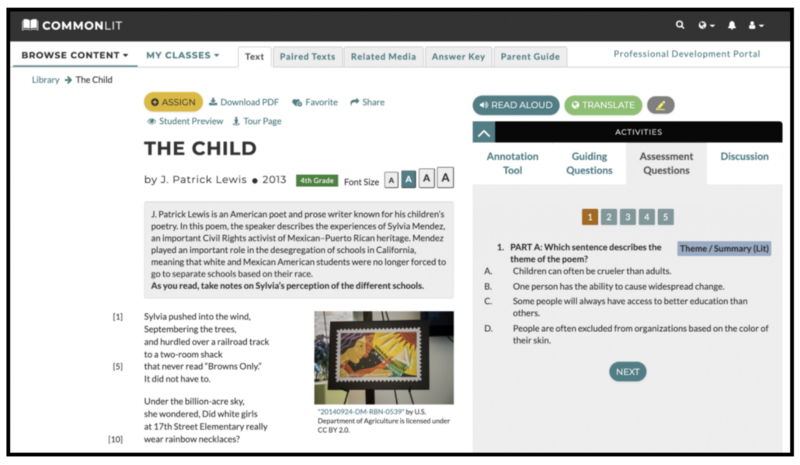Celebrate National Hispanic Heritage Month with texts elementary students will love.
To help pay tribute to amazing Hispanic authors, poets, and social activities, we put together a collection of texts to use during Hispanic Heritage Month with your students. These texts will help build students' writing skills and reading comprehension.
“Sí Se Puede: The Legacy of Cesar Chavez” by Carlos Lossada (3rd Grade)
Cesar Chavez was an American civil rights leader who is known for organizing and advocating for farm workers. This text provides an overview of Chavez’s life, beliefs, and accomplishments.
After reading, have students discuss why Chavez thought working together is the way to gain real power.
“Domino Sundays” by Vivian Fernandez (3rd Grade)
In this story, Yolanda and her abuelo, or grandfather, are going to the park where she watches him play dominoes each Sunday. Dominoes is a game that has cultural significance in many Hispanic communities. This Sunday, Yolanda is going to be Abuelo’s partner for the first time. This is a great text for teaching students about overcoming mistakes and trying your best.
After students read, have them engage in Discussion Question #3: “Dominoes are a special part of Abuelo and Yolanda’s community. What are some games or other things that are a special part of your community?”
"When To Eat Pan Dulce... / Cuándo Se Come Pan Dulce..." by René Saldaña Jr.
Pan dulce is a traditional sweet bread from Mexico. In this poem, written by Mexican-American poet René Saldaña Jr., the speaker tells about the different kinds of pan dulce cooked by their grandmother.
After reading, you can lead a conversation about the intersection of food and culture. Have students answer Discussion Question 1: "Pan dulce is special to the speaker of the poem. What are some foods that are really special to you? When do you eat them? Do you have any special memories connected to these foods?"
"I Will Be A Chemist: Mario José Molina / Voy a Ser Químico: Mario José Molina" by Alma Flor Ada (4th Grade)
Mario José Molina is a famous Mexican chemist who won the Nobel Prize in Chemistry in 1995. In this poem by Alma Flor Ada, the speaker shares how Molina became interested in chemistry.
After reading, show students the Related Media video "Dr. Mario Molina" to give students more background on this influential Mexican-American chemist.
“Bilingual / Bilingüe” by Alma Flor Ada (4th Grade)
In this poem by Cuban-American author Alma Flor Ada, the speaker shares about being bilingual. The poem is written first in English and then in Spanish.
As students read, have them take notes on the speaker's point of view on being bilingual. Then, ask students their point of view on being bilingual. Are any of your students bilingual? What language would they like to learn? Do they think it is important to learn multiple languages? How do their opinions align with or differ from the speaker's opinions?
“The Child” by J. Patrick Lewis (4th Grade)
In this poem, the speaker describes the experiences of Sylvia Mendez, a Mexican-Puerto Rican civil rights activist. As a child, Mendez played an important role in desegregating California schools.
As students read, have them take notes on Sylvia’s perception of the school she will attend.

“Four Skinny Trees” by Sandra Cisneros (4th Grade)
Sandra Cisneros is an influential Mexican-American author, most known for her 1984 novel The House on Mango Street. In this excerpt from the book, Esperanza, a 12-year old Chicana girl growing up in Chicago, compares herself to the trees outside her house.
After students read, play the Related Media video “#ArtIsJustice: Sandra Cisneros on How Art Changes Life,” and ask them: “What does Cisneros mean when she says: ‘If you don’t see yourself reflected in the story, you can’t imagine you making any difference in the world’? Do you agree with her? Why or why not? Do you see yourself reflected in the story?”
"Border Kid" by David Bowles (4th Grade)
David Bowles is a Mexican-American author from South Texas, growing up on the border between the United States and Mexico. In this poem, a boy spends a special day with his father crossing the bridge into Mexico.
After reading, discuss the theme of the poem with students. Then, ask students Discussion Question 1: "In the poem, the boy visits a town across the United States' border in Mexico. How might being a 'border kid' affect one's identity, or the way someone views themselves? Is it possible for someone to be part of two (or more) different countries, cultures, or groups? Are you or anyone you know part of more than one culture?"
“The Challenge” by Gary Soto (5th Grade)
Gary Soto is a poet, novelist, and memoirist with Mexican-American heritage. In this short story, a boy tries to impress the new girl at his school. This is a great text to teach character development.
Students can take notes on the different feelings José experiences as he tries to get Estela’s attention. Then, they can use those notes to answer the short response: “How does José’s attitude toward Estela change during the story?”
“Eleven” by Sandra Cisneros (5th Grade)
In this short story about growing up by influential author Sandra Cisneros, a young girl named Rachel thinks about the meaning of her age. Rachel has just turned eleven, but feels like she is much younger when she has an embarrassing interaction with her teacher.
After students read, play the Related Media video “Sandra Cisneros, Reading, 8 Oct. 1996.” In this video, Cisneros reads “Eleven,” and you can facilitate a conversation with students about Cisneros’ tone and how it contributes to the development of Rachel’s character and perspective.
Next Steps
Looking for more great texts to celebrate Hispanic Heritage Month with your students? Explore our Latinx Authors and History text set!
You can also sign up for one of our free Hispanic Heritage Month webinars, where we will give more relevant text recommendations and teach you how to assign lessons on CommonLit.


